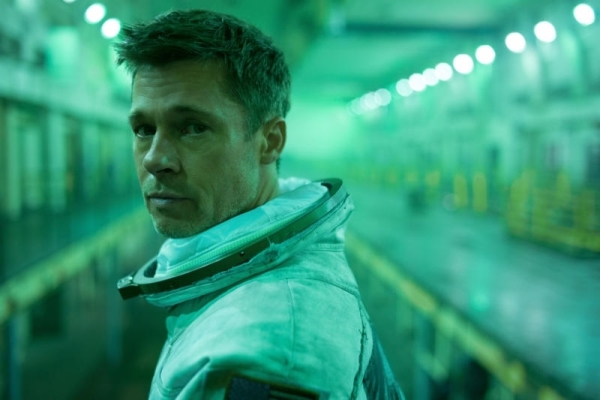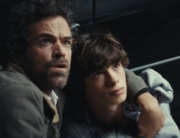Director James Gray’s first five films have been among my favorites for revealing the ambition, tragic flaws, and venality within the grittiness and realism of the outer boroughs of his hometown, New York City, today (such as Two Lovers) and back to the era of his ancestors’ arrival (The Immigrant). He then applied that examination of hope tangled with cynicism to early 20th-century obsessive explorers (The Lost City of Z). With Ad Astra (“to the stars” in Latin), he takes this interpretation of human nature into space in “the near future,” with somewhat less success.
Screenwriters Gray and Ethan Gross emulate the feel of the golden age of science fiction of Isaac Asimov and Arthur C. Clarke, who wrote more about humans than technology as they projected people into space. The pilgrimage of astronaut Major Roy McBride (Brad Pitt), the dominant figure here, seems similarly classic. He goes farther and farther out into the solar system to discover his inner self, a journey he resonantly narrates in a monotone monologue, except when he has to cheerfully speak out loud to an unseen monitor for an AI’s “psych evaluation.”
Even the AI is impressed when Major McBride coolly and calmly, with nary an uptick in his blood pressure, navigates an opening dangerous tangle with the radioactive power surges that are plaguing the globe and atmosphere. He gets called into a top secret briefing where SpaceCom reveals they have determined the surges are coming from the rings of Neptune, where his father, H. Clifford McBride (Tommy Lee Jones), led the Lima Project to find intelligent life in the universe, and was presumed to have disappeared into legend with his crew 16 years earlier. (He’s honored on a tribute wall next to Buzz Aldrin.) Roy accepts the mission to try and stop the disruptions.
The major is first accompanied by Col. Tom Pruitt (Donald Sutherland), an older colleague and friend of his father, as they take the commercial shuttle to the Moon. But they are warned that the Moon is “like the Wild West out there,” with violent conflicts between countries (and pirates) over resource development. Major McBride again acquits himself heroically.
He must get on the Cepheus, the spaceship that will take him to Mars, which has the necessary laser communication link. But the vessel’s captain declares he has to make a detour because of a SOS signal from a Norwegian research ship, with some warning about other species, in an incident that provides more heroism from the major while also referencing similar attacks in other science fiction movies.
In between action, the interior life of the major is full of quick flashback images. He struggles to remember when his stoic, frequently absent father was home and why his estranged wife Eve (Liv Tyler) left him. Eschewing the AI’s questions, he recalls, on his long space travels, how the rigid father he idolized and followed into the same profession was not a good role model for a happy marriage or a fulfilled life.
Astronauts, aeronautical engineers, physicists, and other experts from NASA and its Jet Propulsion Laboratory and Elon Musk’s SpaceX consulted on the film, and cinematographer Hoyte Van Hoytema uses his beautifully metallic palette from his work in Christopher Nolan’s Interstellar (2014). Additionally, Gray managed to use a minimum of green screen effects to actually shoot on practical locations to host realistic interactions among people.
Though the score by Max Richter, with additional music by Lorne Balfe, adds a modernistic audio environment, the conflicts in the climax seem taken directly from Joseph Conrad’s Heart of Darkness (and Francis Ford Coppola’s 1979 adaptation Apocalypse Now). I was expecting to hear “Mistah Kurtz, he dead” ring out in space, though the major interprets the lessons more personally, which is a fresh angle on this old story.
While Ad Astra richly imagines the practical and interpersonal aspects of settlement on the moon and beyond, the insights on human nature are on the simplistic level of pop psychology.







Leave A Comment